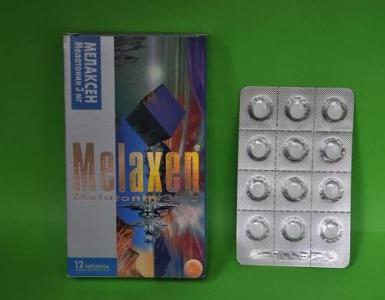What is an electrical circuit. Electrical circuit: elements, principle of functioning
What do we call a chain? These are linked together links. A chain connects two or more objects together. If the chain is broken, then the objects will no longer be connected. When we talk about an electrical circuit, the meaning remains the same. Let's look at what an electrical circuit is and what it consists of.
Elements of electric circuit
When considering the simplest electrical circuits in the eighth class, the following components of the electric circuit are distinguished: load, connecting wires, key.
The source of the current is something that feeds the entire circuit with an electric current, creating in it electric field . As a result, electrons move, and the charge moves from one element of the electrical circuit to the next. The source of the current can be a simple battery, a battery, a 220 V socket and so on.
A load or a current receiver in a general sense is something that consumes an electric current and, as a result, produces a certain work that we need. For example, a normal light bulb is a load. The current, passing through the light bulb, does work to heat the spiral, which causes it to glow.
Connecting wires are wires that connect all the elements of the circuit to each other.
The key is the simplest device for closing and opening the circuit. Switch, knife switch, button - all this different variants keys.
Principle of electric circuit functioning
Thus, the simplest electric circuit functions as follows: from the source, the charge moves along the wires to the load, performs a certain work there and then moves along the wires again to the source. But already to another pole of the source. Electric charge , passing through the load, does some work and, accordingly, loses energy. This energy is replenished in the current source. The key serves to open and close the circuit. That is, at any moment we can open the circuit, and the current will stop running. The light will go out, the engine will stop, the load will stop receiving energy. When the key is closed, the circuit will be restored and the current will flow again.
This is the principle of the functioning of any electrical circuit. As complex and ramified as it may be, the essence still remains the same - the current from the source flows to the receiver and performs a kind of work there. An important condition for the operation of any chain is that it be closed. If the circuit is broken at any place, this will be equivalent to breaking the key, and the current will stop flowing.
In order to visualize the electrical circuit on paper, it is drawn in the form of drawings, which are called diagrams. In the diagrams, all elements of the chain have their own conventions. Any existing chain can be drawn and calculated on paper. Usually the process of creating a complex circuit starts from the drawing on paper, where everything is carefully calculated and thought out before starting to create a real electrical circuit.
In order to use energy electric currentFirst of all, you need a source of current.
Electric motors, lamps, tiles, all kinds of household appliances are called receivers or consumers electric power .
Electric energy must be delivered to the receiver. For this purpose, the receiver is connected to a source of electrical energy by wires.
To turn on and off at the right time, the receivers of electrical energy, use keys, switches, buttons, switches, i.e., closing and disconnecting devices.
The current source, the receivers, the closing devices, interconnected by wires, constitute the simplest electric circuit.
In order to have a current in the circuit, it must be closed, that is, it should consist only of electricity conductors. If in some place the wire breaks, the current in the circuit will stop. (This is the basis for the operation of the switches.)
Drawings showing the connection methods electrical appliances in a chain, called schemes. Instruments on the diagrams are denoted by conventional signs (Figure 49). Figure 50 shows a diagram of the simplest electrical circuit.
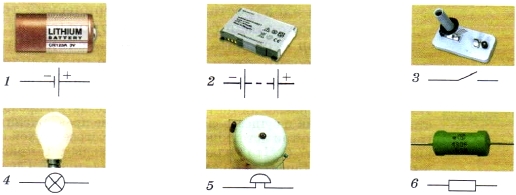
Fig. 49. Symbols used in the schemes:
1 - galvanic cell or battery; 2 - battery of cells and batteries; 3 - the key; 4 - electric lamp; 5 - an electric bell; 6 - resistor (conductor having a certain resistance)
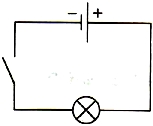
Fig. 50. Diagram of an electrical circuit
Your questions
- What is the purpose of the current source in the electrical circuit?
- What receivers, or consumers, of electrical energy do you know?
- What parts does the electrical circuit consist of?
- What kind of electrical circuit is called closed circuit; open?
Exercise 23
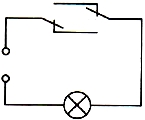
We have already found out that for the use of electricity, things like a current source, conductors, instruments, etc. are needed. In order for all these things to interact, it is necessary to build an electrical circuit, through which energy will be delivered to consumers from a current source. To connect the source to the consumer you need wires. In addition, the consumer should be able to choose when he wants to use electricity, so there are switches and switches. So, in order to have a current in the circuit, it must be closed, i.e. consist only of conductors, through which a current source, a receiver and other circuit elements are connected.
In order to be able to quickly and clearly draw a diagram of the electrical circuit, people came up with a symbol for each element of the circuit. In this lesson we will look at the notation for the simplest elements of a chain, and as we study new constituent parts we introduce the appropriate notation.
The simplest electric circuit includes a source, a light bulb and a switch. Schematically, this chain looks like this:

All are well aware that if you continuously press the switch, you can make the light blink. Now we know what exactly happens when you press the switch: the electrical circuit opens, causing the current to stop flowing through the bulb, and it goes out.
Exercises.
Task 1.In the chain there are two light bulbs and one switch. Is it possible to make one of the bulbs burn, but one - do not burn?
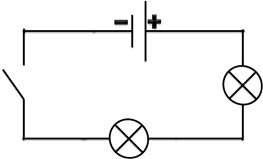
No, because the switch either closes or opens the circuit. Therefore, the current either passes through both lamps, or does not pass through one of them.
Task 2. What kind of chain should be built with two light bulbs so that you can not light one of them, light only one or light both?
From the previous problem, we already saw that there must be two switches in the circuit: the first to open the entire circuit, and the second to turn off one of the light bulbs from the network.
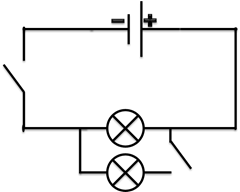
Task 3. The figure shows a chain with three bulbs. Is it possible to make only two of them burn?

Of course not. The figure does not indicate the source of the current, and without it, none of the bulbs will turn on. This scheme corresponds to the fact that wires and switches are connected to the bulbs.



